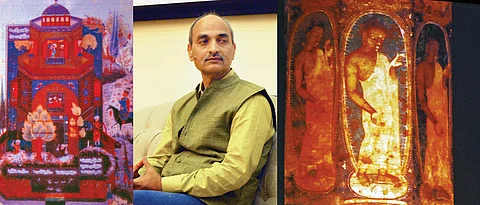

If there’s one thing that Dr Shrikant Pradhan would like his audience to retain from his lecture on ‘Murals to Miniatures’, it would be to remember that art is ever flowing and changing. Speaking at Vedh-Retrospection, a series of programmes and activities organised by Maharaja Shivachhatrapati Pratishthan Pune and INTACH Pune Chapter, to promote preservation of heritage, Dr Pradhan traced the journey of art from 5th century AD to 18th century British-India. In his two hour speech, Pradhan also spoke about techniques, composition and pigments and what do they tell us about the prevalent society.
Ajanta paintings
“The murals and wall paintings of Ajanta caves are the genesis of Indian art. These are the classical paintings of India, dating to 5th-6th century AD and understanding their style, composition, techniques, subject and pigments tells us about our society and the historical and geographical relations between us and other countries,” he began.
We can spot the use of Lapis Lazuli in some of the paintings at Ajanta. “Lapis Lazuli is a blue pigment found in Badakhshan region of Afghanistan. This bit of information allows you to establish pigment trade links between Afghanistan and this region. Some of the art works of Ajanta have bearings of Gandhar art from Afghanistan, with some Greek influences. The lines of Ajanta drawings are more lyrical. Gandhar art is known for its folds. These two elements are in evidence at Ajanta. But, as is typical of any art journey, the Indian artists have used these influences and styles to come up with something unique, our individual style,” pointed out Pradhan.
Art of any period draws out cultural references and symbols of the society it is born in. For instance, lotus, which is one of the common symbols, is widely used. You also find these symbols and destinations in literature of Kalidasa, the famous poet, and other writers.
From Ajanta, Pradhan moves to Kailash caves in nearby Verul or Ellora. “Ajanta caves told stories of Tathaagata’s life (his birth and rebirth in various forms till he becomes Enlightened, the Buddha) and the virtues that we need to imbibe in our lives. Whereas the Verul caves reflected Shaivism. The Nandi mandapam in Kailash temple, has to be seen in two parts. One dates to 8-9th century, and another part depicts an art form that came 100-150 years later. In the decoration of ceiling, you can see the lines of Ajanta. Thereafter, the lines of the paintings became more bold, linear. There were newer ways for decoration and ornamentation,” he added.
This form continued until 12th century or so, when there was no evidences of wall art — there were references of them in literature, but no physical evidences, maybe because they were vandalised. Or the paintings got spoilt.
Mughal art
Before we talk about the emergence of Maratha art in the 18th century, we should go a little back in time in the north. “The tradition of wall paintings is stylistically changed in later centuries because of introduction of paper in 16th-17th century. The paper from China came to India via Samarkand. Around the same time, Persians come to India during Mughal rule. They come with their idiom of art — the Mughal Miniatures. The local people work with them in the atelier created by Akbar for the artists and artisans. This fusion of ideas and work has given birth to Mughal art,” explained Pradhan, who is a miniature artist. The miniatures also spread to other provinces in the country, giving rise to ‘Darbari art’, with the stamp of local style.
The Mughal art has also been influenced by European art, because Akbar had sent his artists to Goa. There was also some influence of European art, mainly the portraits trend of the British.
European and Maratha art
Speaking of influence of European art on Maratha art that emerged during Peshwa era, Pradhan says, “Artist James Wales came to Pune, in the Peshwai era. He did a few portraits of the Peshwa and the nobility. He also took Gangaram Tambat, a local artist, as his assistant. Both learnt from each other and in that process Tambat created a new thought. This is how Western art of portraiture was introduced in Pune.”
The Dakhani art, which was influenced by Mughal art, had a strong bearing on Maratha art. The Maratha art also borrowed the style of Rajasthan-Malwa art, but the figurative images had distinct Maratha/Marathi look. “The women were draped in kashta sarees, with kunkwachi chiri on their forehead and wearing nath in their nose. These Maharashtrian connotation separates it from the Dakhani and Malwa art. The patrons were the Peshwa and other nobles. In Peshwai era, you can see some art work in wadas. But the distinctly Marathi figurative drawings can be seen on the pothis (small prayer booklets) like Bhagwat Puran and Shiv Leela,” he adds. This form eventually defined Raja Ravi Varma paintings and the proliferation of art in our homes.
He concluded on the note that art is always flowing and ever changing. The tributaries might change the course, but it flows on.
